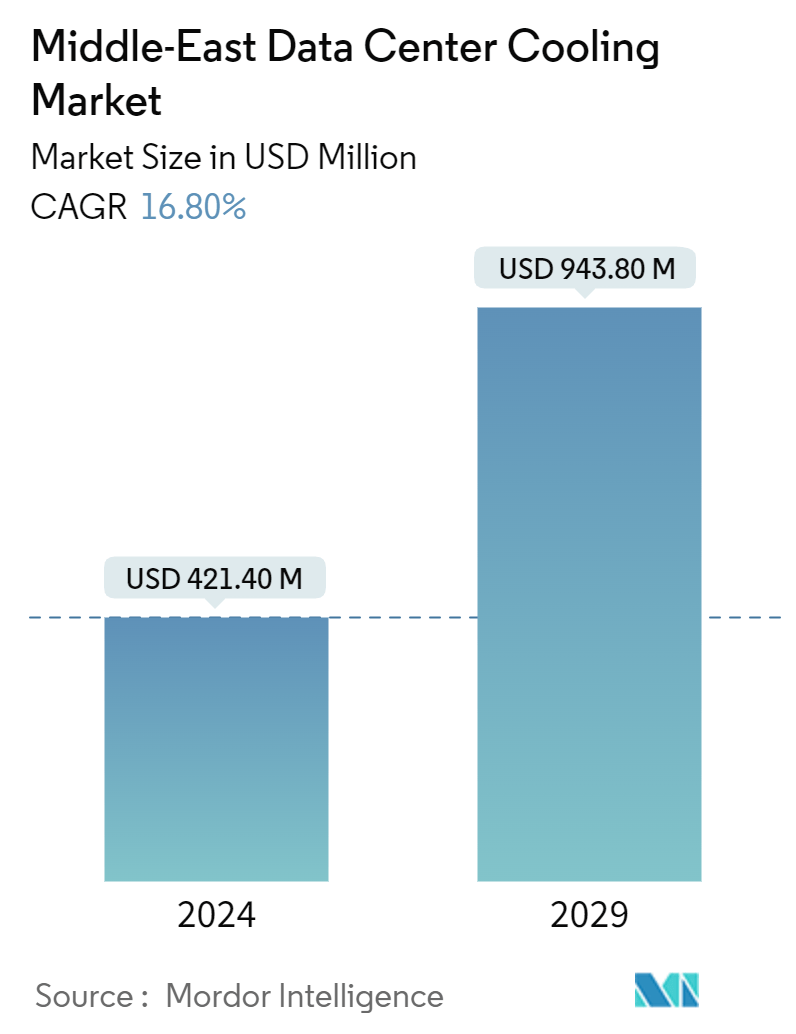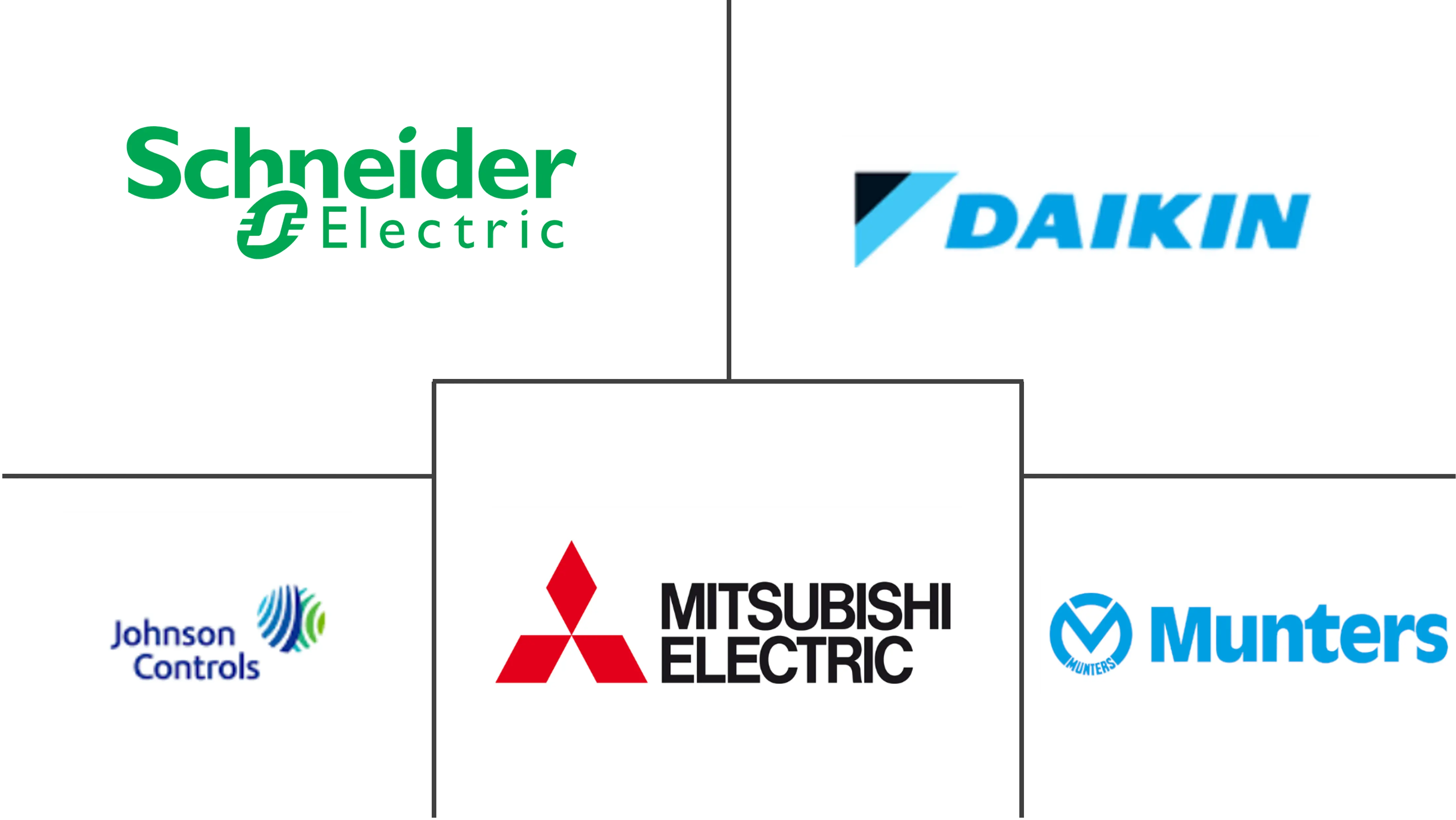Market Size of Middle-East Data Center Cooling Industry

| Study Period | 2019 - 2029 |
| Base Year For Estimation | 2023 |
| Market Size (2024) | USD 421.40 Million |
| Market Size (2029) | USD 943.80 Million |
| CAGR (2024 - 2029) | 16.80 % |
| Market Concentration | Medium |
Major Players
*Disclaimer: Major Players sorted in no particular order |
Middle-East Data Center Cooling Market Analysis
The Middle-East Data Center Cooling Market size is estimated at USD 421.40 million in 2024, and is expected to reach USD 943.80 million by 2029, growing at a CAGR of 16.80% during the forecast period (2024-2029).
The increasing demand for cloud computing among SMEs, government regulations for local data security, and growing investment by domestic players are major factors driving the demand for data centers in the region.
Under Construction IT Load Capacity: The upcoming IT load capacity of the Middle Eastern data center construction market is expected to reach 2,059.5 MW by 2029.
Under Construction Raised Floor Space: The region's construction of raised floor area is expected to increase 9.7 million sq. ft by 2029.
Planned Racks: The region's total number of racks to be installed is expected to reach 496K units by 2029. Saudi Arabia is expected to house the maximum number of racks by 2029.
The Middle East has a Mediterranean climate with hot, dry summers and mild, rainy winters. However, harsh winter conditions continue in the mountains of Iran and Iraq. Precipitation is generally meager, ranging from 350 mm to 750 mm annually. The region is known for being hot and dry. The choice of cooling technology is typically based on the geographic location of the data center.
Planned Submarine Cables: Close to 26 submarine cable systems are connecting the Middle East, and many are under construction. One submarine cable, Blue, is projected to begin service in 2024. It spans over 4,696 kilometers and has a landing point in Tel Aviv.
Middle-East Data Center Cooling Industry Segmentation
Data center cooling is a set of techniques and technologies to maintain optimal operating temperatures in data center environments. Data center cooling is critical as facilities house many computer servers and network equipment that generate heat during operation. Efficient cooling systems are used to dissipate this heat and prevent equipment from overheating, ensuring continued reliable operation of the data center. Various methods, such as air conditioning, liquid cooling, and hot/cold aisle containment, are commonly used to control temperature and humidity in data centers.
The Middle Eastern data center cooling market is segmented by cooling technology (air-based cooling (CRAH, chillers and economizers, and cooling towers), liquid-based cooling (immersion cooling and direct-to-chip cooling), end user (IT & telecommunication, BFSI, government, and media & entertainment). The market sizes and forecasts are provided in terms of value for all the above segments.
Middle-East Data Center Cooling Market Size Summary
The Middle East data center cooling market is poised for significant growth, driven by the increasing demand for cloud computing, stringent government regulations on data security, and substantial investments from local players. The region's unique climatic conditions, characterized by hot and dry summers, necessitate advanced cooling solutions for data centers. The proliferation of digital initiatives, such as 5G and digital payments, alongside the rise in smartphone usage, is contributing to the surge in data consumption and internet usage, thereby boosting the demand for data centers and, consequently, cooling equipment. The entry of major cloud service providers into the region further underscores the need for efficient cooling solutions to support the expanding data center infrastructure.
Saudi Arabia is emerging as a key technology hub within the region, with significant investments from tech giants like Google, Microsoft, and IBM, aligning with the country's Vision 2030 goals. The expansion of data centers in response to increased data storage needs, driven by the growth of e-commerce and high-speed internet adoption, is further propelling the demand for cooling solutions. The competitive landscape of the Middle East data center cooling market is marked by the presence of major players such as Schneider Electric SE, Daikin Industries Ltd, and Johnson Controls International PLC, who are focusing on innovative cooling technologies. Recent developments, including partnerships and the introduction of advanced cooling systems, highlight the ongoing efforts to enhance data center infrastructure in the region.
Middle-East Data Center Cooling Market Size - Table of Contents
-
1. Market Dynamics
-
1.1 Market Overview
-
1.2 Market Drivers
-
1.2.1 Increasing Trend of High-Performance Computing across Europe
-
1.2.2 Growing Rack Power Density
-
-
1.3 Market Restraints
-
1.3.1 High Initial Investments
-
-
1.4 Value Chain / Supply Chain Analysis
-
1.5 Industry Attractiveness - Porter's Five Forces Analysis
-
1.5.1 Threat of New Entrants
-
1.5.2 Bargaining Power of Buyers/Consumers
-
1.5.3 Bargaining Power of Suppliers
-
1.5.4 Threat of Substitute Products
-
1.5.5 Intensity of Competitive Rivalry
-
-
1.6 Assessment of the COVID-19 Impact
-
-
2. MARKET SEGMENTATION
-
2.1 Cooling Technology
-
2.1.1 Air-based Cooling
-
2.1.1.1 CRAH
-
2.1.1.2 Chiller and Economizer
-
2.1.1.3 Cooling Tower
-
2.1.1.4 Other Air-based Cooling
-
-
2.1.2 Liquid-based Cooling
-
2.1.2.1 Immersion Cooling
-
2.1.2.2 Direct-to-chip Cooling
-
-
-
2.2 End User
-
2.2.1 IT & Telecommunication
-
2.2.2 BFSI
-
2.2.3 Government
-
2.2.4 Media & Entertainment
-
2.2.5 Other End Users
-
-
2.3 Country
-
2.3.1 Saudi Arabia
-
2.3.2 United Arab Emirates
-
-
Middle-East Data Center Cooling Market Size FAQs
How big is the Middle-East Data Center Cooling Market?
The Middle-East Data Center Cooling Market size is expected to reach USD 421.40 million in 2024 and grow at a CAGR of 16.80% to reach USD 943.80 million by 2029.
What is the current Middle-East Data Center Cooling Market size?
In 2024, the Middle-East Data Center Cooling Market size is expected to reach USD 421.40 million.

